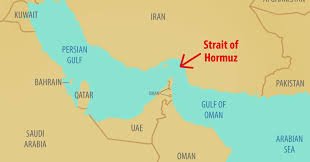The Strait of Hormuz—just a 21-mile-wide chokepoint between the Persian Gulf and the Arabian Sea—has long been one of the most strategically significant maritime routes in the world.
As tensions escalate in the Middle East following U.S. airstrikes on Iranian nuclear facilities and the Iranian parliament’s recent approval of a motion to shut down the strait, the global community is bracing for the consequences of what could be one of the most disruptive geopolitical flashpoints of the decade.
In this blog, we explore what happens if Iran actually closes the Strait of Hormuz, how the world’s oil markets, global trade, regional politics, and military dynamics will be affected, and why this seemingly narrow passage holds the power to shake the foundations of the global economy.
Why the Strait of Hormuz Matters
The Strait of Hormuz is the world’s most critical oil transit chokepoint.
Nearly one-third of all global seaborne traded oil—about 20 million barrels per day—passes through this narrow waterway, including exports from Saudi Arabia, Iraq, Kuwait, Qatar, and the United Arab Emirates.
Beyond oil, the strait also serves as a major route for liquefied natural gas (LNG), particularly from Qatar, the world’s largest LNG exporter. This trade route supports energy supplies to major economies like Japan, South Korea, China, and India. Any disruption can send global energy prices skyrocketing overnight.
Can Iran Really Close the Strait of Hormuz?
Iran has long claimed it could shut down the Strait of Hormuz “within hours” in response to any foreign aggression. Its elite Islamic Revolutionary Guard Corps (IRGC) Navy is known for swarm tactics, sea mines, fast-attack crafts, and anti-ship missiles stationed along the northern coastline.
While the U.S. Navy’s Fifth Fleet and allied forces in the region can challenge such a move militarily, Iran has the advantage of geographic proximity, asymmetrical warfare, and surprise tactics.
Even a temporary disruption of traffic in the strait could cause immense logistical chaos and psychological shockwaves across global markets.
READ MORE Iranian Parliament Approves Closure of Strait of Hormuz
Global Oil Prices: A Spike No One Wants
If the Strait of Hormuz is closed, even for 48–72 hours, oil prices could jump to $150–$200 per barrel or beyond, depending on the scale of disruption and damage.
For comparison, during the Iran-Iraq tanker wars of the 1980s, oil prices surged despite fewer technological dependencies and alternatives than today.
Today’s energy-dependent economies—from the U.S. and EU to China and India—would face a fuel inflation shock, affecting everything from gasoline prices to food supply chains.
Impact on Global Shipping and Insurance
Beyond oil, about 35% of all maritime trade from the Gulf region flows through Hormuz. If shut, cargo ships would need rerouting—if that’s even possible—at great cost and delay.
Shipping insurance premiums for operating in the region would soar overnight, classified under “war risk” zones. This cost would ripple down to consumers worldwide, adding pressure on already fragile post-pandemic supply chains.
Qatar and LNG Disruption
Qatar exports over 70% of its LNG via Hormuz.
A shutdown could cause European and Asian gas prices to spike dramatically, especially in nations already facing winter energy crunches. Countries like Germany, Japan, South Korea, and even Pakistan would see shortages and blackouts unless emergency reserves are used.
The crisis would also throw Europe’s energy transition plans into disarray, forcing countries to return to coal or nuclear options to compensate.
Military Response and Escalation
A formal closure of the Strait would almost certainly trigger a multinational military response, especially from the U.S., UK, France, and Gulf allies. Expect an immediate increase in U.S. Navy deployments in the region, reconnaissance flights, and perhaps a direct naval confrontation with Iran’s IRGC forces.
There’s also the risk of Iran deploying sea mines, which are cheap, hard to detect, and devastating to large oil tankers. Clearing them could take weeks or months.
This could lead to a wider regional war involving Israel, Saudi Arabia, the UAE, and possibly non-state actors like the Houthis in Yemen or Hezbollah in Lebanon, creating a multidimensional regional security crisis.
The China and India Factor
China and India, as top importers of Gulf energy, will be forced into uncomfortable diplomacy. Both countries are expected to push for de-escalation, but if the Strait remains closed, they might reconsider their strategic investments and alliances in the region, and possibly increase their naval presence near the Indian Ocean.
Beijing, particularly, may seek bypass routes through Iran-Pakistan pipeline projects or alternative BRI corridors, accelerating investment in overland energy security.
Could the Global Economy Fall into Recession?
A prolonged Hormuz shutdown could tip the global economy into recession, particularly if combined with other crises such as ongoing conflicts in Ukraine, Gaza, or political instability in Asia or Africa. Central banks would face dilemmas: fight inflation or preserve growth.
Expect stock markets to tumble, inflation to spike, and consumer confidence to plummet, especially in countries highly reliant on energy imports.
Diplomatic Fallout and UN Gridlock
Closure of the strait would also lead to intense UN Security Council debates, with Western powers likely blaming Iran and seeking sanctions, while Russia and China may block such moves—creating yet another stalemate at the global diplomatic level.
This could also force countries to reassess alliances, with the U.S.-Iran standoff becoming a litmus test for broader global alignments in the emerging multipolar world order.
A High-Stakes Gamble
Closing the Strait of Hormuz is not a symbolic act—it is a strategic gamble with global consequences. Iran knows this. The world knows this. But if Tehran feels cornered—politically, economically, or militarily—this ancient maritime gateway could be used as leverage.
For now, markets remain jittery, diplomats are scrambling, and militaries are on alert.
Whether or not the Strait is closed, the mere threat has already reminded the world of how interconnected and fragile our energy and security architectures truly are.
The Diplomatic Insight is a digital and print magazine focusing on diplomacy, defense, and development publishing since 2009.



